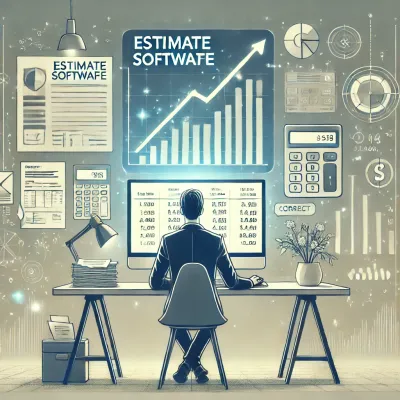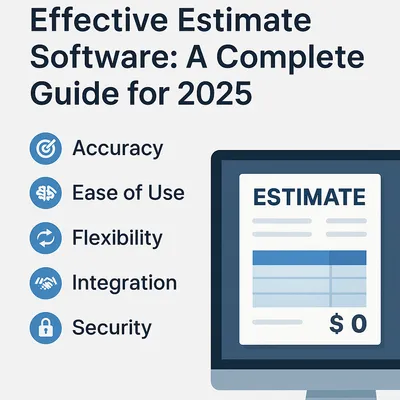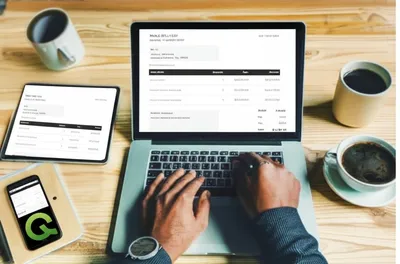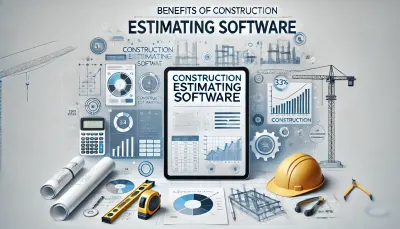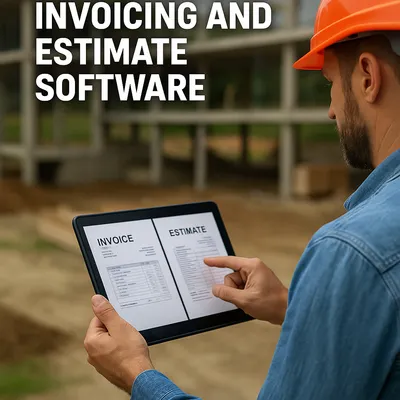Plumbing Estimation Software (2026 Guide)
Discover how plumbing estimation software and QuickAdmin help plumbers ditch spreadsheets, create faster bids, and win more profitable jobs in 2026.
by
Eng. José Manuel Siso Colmenares • 11/21/2025
Plumbing Estimation Software: Ditch the Calculator, Win More Jobs (2026 Edition)
Updated: November 21, 2025
You already know the feeling: it’s 10 p.m., you’re juggling three open quotes, and you’re still tweaking a spreadsheet to price a repipe, a water-heater replacement, and an emergency leak repair. One wrong cell, and there goes your margin.
Here’s the question this article will answer by the end:
How would your plumbing business look if estimates, invoices, time tracking, and cash flow lived in one tool you can use from your phone — without giving up control of your numbers?
We’ll walk from “Flintstones-style” takeoffs to AI-assisted plumbing estimation software, and see exactly where QuickAdmin fits in that evolution.
The Problem (and Opportunity) Behind Plumbing Estimates
A quiet profit killer hiding in your estimates
Construction and specialty trades often work on thin profit margins — typically in the low single digits. A small estimating mistake can quietly erase the profit from an entire month.
A study on construction estimating shows that inaccurate estimates can lead to around 3% profit loss on awarded tenders and significantly lower win rates when bids are off target. That 3% is the difference between a healthy business and constant stress for many contractors.
Source: Conwize – The high cost of errors and inaccurate estimates.
At the same time:
- The construction estimating software market was valued around $1.5B in 2024 and is forecast to grow at double-digit CAGR through 2030.
Source: Grand View Research – Construction Estimating Software Market. - Yet an industry report notes that roughly 38% of small and regional contractors still rely on spreadsheets and manual methods for estimating.
Source: Market Reports World – Construction Estimation Software Market.
So there’s your gap:
Plumbers who move from manual tools to trade-aware plumbing estimation software gain an immediate edge in speed, accuracy, and professionalism.
That’s exactly the gap QuickAdmin is designed to fill.
If you want a broader view on why estimates matter so much to small businesses, check our previous posts:
- Benefits of Construction Estimating Software
- 5 Ways Estimate Software Saves Time for Busy Plumbers
- How Estimating Software and Free Invoice Tools Boost Business
From Parchment to PWA: How Plumbing Estimation Evolved
Your original outline of “eras” is spot on. Let’s reframe it for plumbers and for the reality of 2026.
1. The “Flintstones Era”: Scale rulers, yellow pads, and gut feeling
Before the 1980s, everything lived on paper:
- Blueprints on the desk, scale ruler in hand.
- Handwritten notes from walk-throughs.
- Basic calculators and ballpark “rules of thumb.”
It worked… until:
- A missed ¾” hot line turned into an unpaid change order.
- A misread scale made your copper bill explode.
- A notebook with all your numbers disappeared in the truck.
Slow, manual, and easy to mess up.
2. The Spreadsheet Revolution: Excel everywhere
In the 80s and 90s, Excel became the default “estimating software” for construction and trades. Even today, many contractors still run everything inside a monster workbook.
A recent analysis highlights that over 80% of construction firms have relied on Excel for estimating, despite the rise of dedicated software.
Source: The Access Group – Excel vs Construction Estimating Software.
Spreadsheets were a step forward, but:
- One broken formula can corrupt dozens of plumbing estimates.
- File names like
plumbing-estimate-final-v7-REAL-FINAL.xlsxbecome normal. - No automatic price updates, no trade assemblies, no integration with invoicing.
3. Early digital takeoffs: first trade-specific tools
Late 1990s–2000s: dedicated estimating platforms for mechanical, electrical, and plumbing (MEP) trades appear.
They bring:
- Digital on-screen takeoffs from plans instead of scale rulers.
- Databases of materials and assemblies tuned to MEP trades.
They’re powerful, but often:
- Expensive and locked to one desktop.
- Complex to set up.
- Designed for full-time estimators, not small service crews.
4. CAD, BIM and trade-specific databases
As CAD and BIM became standard, estimating tools started reading model data directly: pipe lengths, fixture counts, elevation changes.
For large commercial plumbing contractors this means:
- Fewer takeoff errors.
- Better coordination with GCs and other trades.
- A clearer view of complex systems (medical gas, fire suppression).
But many residential / light commercial plumbers still live far from that BIM world.
5. Cloud & AI: Where QuickAdmin comes in
Cloud construction software is growing fast. One report values the construction management software market at over $10B in 2025 and forecast to reach around $16–17B by 2030, driven largely by cloud adoption.
Source: Mordor Intelligence – Construction Management Software Market.
In parallel:
- AI takeoff tools claim up to 90% faster takeoffs, meaning more bids with the same staff.
Source: Beam AI – AI Takeoff Software. - Integrations like DESTINI Estimator + Togal.AI report 80% faster digital takeoff and around 90 minutes saved per drawing sheet.
Source: Beck Technology – Is ChatGPT Going to Replace Estimators?.
And for plumbing specifically, analysts estimate the plumbing estimating software market at around $1.5B in 2023, expected to more than double by 2032.
Source: DataIntelo – Plumbing Estimating Software Market.
QuickAdmin lives in this phase:
- Cloud-based, PWA: runs on any device, installable on your phone or tablet as an app.
- All-in-one: estimates, invoices, time tracking with geolocation, job management, clients — in one platform.
- Made for SMEs: designed around small contractors, not giant construction conglomerates.
We’ve explained this positioning in other posts like
PWA Billing, Estimating & Time-Tracking Software, and this guide applies it specifically to plumbing.
Your Digital Toolbox Today: What Modern Plumbing Estimation Software Does
Think of modern plumbing estimation software as a digital toolbox, not just an app. The goal isn’t to “make a nice PDF”, it’s to reduce risk, save hours, and feed your entire business workflow.
We’ll use QuickAdmin as an example so you can visualise it in action.
Core “superpowers” you should demand
1. Automated cost calculations
A serious tool should handle:
- Materials: pipe, fittings, valves, fixtures, hangers, insulation.
- Labor: rough-in, trim-out, demo, travel time, after-hours rates.
- Overhead & profit: markup, contingency, permit / inspection fees.
QuickAdmin lets you build reusable assemblies:
- “3-piece bathroom rough-in”
- “Tankless water heater replacement”
- “Drain cleaning visit”
You stop rebuilding the same quote from scratch and start adjusting a base that already works — exactly the logic we promote in
Benefits of Estimate Software for Small Businesses.
2. Live or regularly updated price lists
Copper, PEX and fixtures move with the market. Many plumbers still:
- Call supply houses for every mid-size job.
- Manually check Home Depot or Lowe’s online.
Modern tools — and QuickAdmin in particular — can:
- Pull current material prices during estimating (QuickAdmin offers a limited number of free Home Depot price checks in some plans).
- Show how cost changes affect margin before you send the quote.
This is one of the main ideas in
Benefits of Construction Estimating Software: faster, more accurate pricing with less manual work.
3. Professional proposals in minutes
QuickAdmin generates clean, branded proposals automatically:
- Scope separated by room / system (kitchen, bathrooms, mechanical room).
- Line items with quantity and price (or just totals if you prefer).
- Custom terms and notes in one document.
If you’ve read
Invoice Software for Landscapers, you know we care a lot about how proposals look — because professional layout builds trust and makes approvals easier.
4. Dynamic adjustments
Real life = change orders.
A good estimating tool should:
- Recalculate totals when you change pipe type, fixture model, or labor.
- Let you run “what-if” scenarios (“What if I use CPVC instead of copper here?”).
- Compare estimate vs. actual for continuous improvement.
💡 Insight: Don’t just look for “free plumbing estimate software”; look for tools that make it easy to adjust when suppliers, clients, or inspectors change the rules on you.
Beyond the Estimate: Why QuickAdmin Is More Than a Calculator
Most plumbers don’t want to just create a nice estimate PDF and move on. You want that estimate to:
- Become a job in your system.
- Drive scheduling and time tracking.
- Turn into an invoice with minimal clicks.
That’s where QuickAdmin becomes more than “estimating software”.
A. Business command center, not a lone app
QuickAdmin combines:
- Estimating (fixed price or time & material).
- Invoicing and payments (partial invoices, deposits, final bills).
- Job & client management (contacts, addresses, notes, attachments).
- Time tracking with geolocation for crews out in the field.
So when you create an estimate for a plumbing remodel, you can later:
- Convert it into a job once the client approves.
- Track hours on that job using your team’s phones.
- Convert the approved estimate into an invoice in one click.
We talk about this “estimate → invoice” flow in more detail in:
- Electronic Invoicing Software for SMBs: Best Options
- How Estimating Software and Free Invoice Tools Boost Business
B. PWA: Your pocket office on site
Because QuickAdmin is built as a Progressive Web App (PWA):
- You can add it to your phone’s home screen — no app store needed.
- It feels like a native app, not a sluggish website.
That’s exactly the idea behind
PWA Billing, Estimating & Time Tracking Software: your office literally in your pocket.
C. A free plan that actually lets you test it
We know most 2–5 person plumbing crews don’t want to commit before seeing real value.
QuickAdmin’s free tier is designed to be usable, not just a demo:
- Create a limited number of estimates and invoices per month.
- Manage real clients and jobs.
- See if it fits your workflow before upgrading.
(Exact limits may evolve; always check the current pricing page for details.)
Step-by-Step: How a Plumber Uses QuickAdmin in Real Life
Let’s turn all this theory into a practical sequence you can follow this week.
Step 1 – Set up your plumbing templates and assemblies
Start by creating:
- A “standard bathroom rough-in” assembly (pipe, fittings, labour hours).
- A “tankless water heater replacement” package.
- A “drain cleaning visit” with call-out fee and minimum time.
You save each as a reusable template. Then every time you create an estimate for a water heater or drain cleaning, you’re adjusting a base — not rewriting a quote from zero.
Step 2 – Price a real job in minutes, not hours
Imagine the call:
“We’ve got low pressure on the second floor and two toilets that gurgle when the washer drains.”
You:
- Open QuickAdmin on your phone.
- Create a new client (or select an existing one).
- Add line items.
- Adjust quantities and time for this particular home.
- Add permit / inspection fees and your standard markup.
- Generate a professional proposal and email it before you leave the driveway.
No more “I’ll send you the quote tonight” — you quote while the problem is fresh in the customer’s mind.
Step 3 – Turn an approved estimate into an invoice in one click
Once the customer approves (by email, phone, or signature):
- Convert the estimate into a jobç in QuickAdmin.
- Assign it to yourself or a tech.
- When the work is complete, convert the same estimate into an invoice.
Because all the data lives in one place:
- No retyping.
- No mismatched line items.
- No “what did we actually include in this price?” confusion.
Step 4 – Learn from every job
Over time, QuickAdmin lets you see:
- Which job types bring better margins.
- How accurate your labour assumptions are.
- Where you routinely add discounts to win work.
That’s how you build a data-driven plumbing price book, instead of a folder of random Excel files.
💡 Insight: The real win isn’t just “a faster estimate.” It’s building a feedback loop between your estimates, your actuals, and your pricing decisions.
QuickAdmin vs Other Plumbing Estimation Tools (Quick Comparison)
In your original notes you mentioned tools like ServiceTitan, Jobber, Field Promax, STACK, McCormick, PlanSwift, TurboBid and others. Many of them are strong products, and you should absolutely compare:
- ServiceTitan – heavy-duty field-service management.
- Jobber – popular with home service businesses.
- McCormick Systems – strong for mechanical, electrical and plumbing takeoff.
(Good “competitor study” if you want to see trade-specific features.)
Another good “competitor study” style overview is this market snapshot:
Construction Estimating Software Market – Trends and Forecasts.
Here’s how QuickAdmin positions itself in that landscape:
| Feature / Focus | QuickAdmin | ServiceTitan / Jobber (field service suites) | PlanSwift / STACK / McCormick (takeoff 1st) |
|---|---|---|---|
| Target user | Small contractors: plumbing, HVAC, landscaping, SMB | Growth-stage service companies with larger teams | Full-time estimators for MEP & GC firms |
| Estimating + invoicing in the same UI | Yes, tightly integrated | Yes, but often via multiple modules | Estimating only (invoicing handled elsewhere) |
| Time tracking with geolocation | Built-in | Often included | Usually not core |
| PWA (no app store required) | Yes | Native mobile apps | Mostly desktop / browser |
| Complexity for a 3-person shop | Lightweight, SME-friendly | Powerful but can feel heavy for very small teams | Built for specialist estimators |
| Free tier for testing real jobs | Yes | Limited free trial | Trials mainly focused on takeoff |
| “Bid-to-cash” continuity (estimate → job → invoice) | Core design | Strong, but more configuration & higher price point | Needs external systems |
🎯 Takeaway: If you’re a 2–10 person crew that wants estimating, invoicing, and time tracking under one roof (without enterprise-level pricing), QuickAdmin is built for that exact profile.
Real-World Scenarios: What Changes When You Go Digital
Let’s ground this in a few concrete scenarios.
Scenario 1 – The 3-person residential plumbing crew
Before
- Estimates in Excel, invoices in Word, time sheets on paper.
- Sunday nights lost to admin.
- Occasional “forgotten invoice” or underpriced job.
After QuickAdmin
- Estimates created from templates on your phone at the customer’s house.
- One-click conversion of approved estimates into jobs and invoices.
- Time tracking tied to each job, with GPS context.
Result: admin time drops, cash-flow visibility improves, and you finally know which jobs actually make money.
Scenario 2 – Mixed-trade small company (plumbing + landscaping + handyman)
QuickAdmin isn’t only for plumbing. It’s designed for multi-trade small businesses:
- One central client database.
- For all sectors: plumbing, irrigation, fencing and small renovations.
- Unified invoicing and payment tracking.
Instead of three different tools, you have one software of administration tuned to small contractors.
Scenario 3 – Growing from solo to small team
Maybe you start alone, using QuickAdmin as free invoice and estimate software.
As you grow:
- Add users with roles (tech, office admin, estimator).
- Control what each one can see or edit.
- Keep cost codes and price lists consistent across the team.
That’s the growth path we had in mind from the beginning for QuickAdmin: start small, scale up without re-platforming.
Conclusion: Supercharge Your Plumbing Business, One Estimate at a Time
Plumbing estimation software is no longer a “nice-to-have.” It’s part of the basic toolkit for any serious plumbing business.
The data is clear:
- Inaccurate estimates are a major driver of lost bids and margin erosion — something highlighted repeatedly in industry articles on common estimation mistakes.
Example: McCormick – Common Construction Estimating Mistakes and Beam AI – Estimation Mistakes to Avoid. - Estimating and takeoff software adoption continues to climb, while spreadsheet-based estimating slowly declines as projects grow more complex.
Example: Market Reports World – Construction Estimation Software Market.
At the same time, some fundamentals never change:
- You still need to understand plumbing systems.
- You still need sound pricing logic.
- Software doesn’t replace a good estimator — it multiplies their impact.
QuickAdmin is built exactly for you: small and mid-sized contractors, plumbers, landscapers, and service businesses who want big-company tools without big-company complexity or cost.
If you’re still:
- Wrestling with Excel for every quote,
- Re-typing client data from estimate to invoice, or
- Guessing how profitable last month really was…
…then your next strategic move is simple:
👉 Create your next plumbing estimate inside QuickAdmin, send the invoice from the same platform, and see how it feels to finally have your numbers connected end-to-end.
FAQ
1. What is plumbing estimation software?
Plumbing estimation software is a digital tool that helps plumbers and mechanical contractors calculate materials, labour, overhead, and profit for each job. It replaces paper notes and spreadsheets with accurate, repeatable workflows, typically including templates, price lists, and professional proposals.
2. Can I use QuickAdmin as plumbing estimation software?
Yes. QuickAdmin was designed for small contractors — including plumbers — and lets you create estimates, attach photos, and convert approved estimates into jobs and invoices from the same place.
3. Does QuickAdmin have a free plan for plumbers?
QuickAdmin offers a free tier with limited but real usage, so you can test it on actual plumbing jobs instead of a sandbox. You can create a limited number of estimates, invoices, and jobs per month, manage clients, and see if it fits your workflow before upgrading. Always check the pricing page for the latest limits.
4. Can I create estimates and invoices from my phone?
Absolutely. QuickAdmin is a Progressive Web App (PWA), so you can add it to your phone’s home screen and use it like a native app. You can create, edit, and send estimates and invoices from smartphone, tablet or any devices.
5. Is QuickAdmin only for plumbing businesses?
No. QuickAdmin is designed for small and medium-sized service businesses: plumbing, landscaping, construction, cleaning services, and more. You can create different templates per trade and keep everything under one roof: estimates, invoices, time tracking, and clients.
6. How is QuickAdmin different from bigger platforms like ServiceTitan or Jobber?
QuickAdmin focuses on being simple, affordable, and tightly integrated for SMEs that want estimating, invoicing and time tracking together. Larger platforms like ServiceTitan or Jobber offer many modules but often at higher cost and complexity, which can be overkill for a 2–10 person crew.



